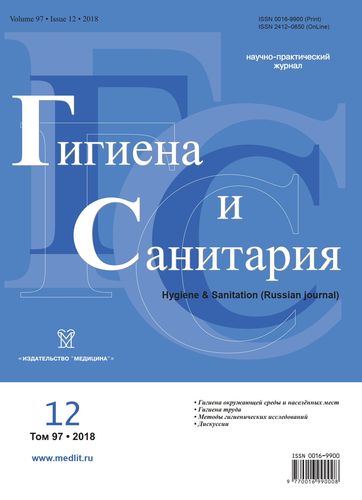Cases of tick-borne dermatitis, caused by Ornithonyssus Bacoti, in medical workers
- Authors: Chistyakov N.D.1
-
Affiliations:
- North-West Scientific Center of Hygiene and Public Health
- Issue: Vol 97, No 12 (2018)
- Pages: 1249-1252
- Section: DISCUSSIONS
- Published: 21.10.2020
- URL: https://ruspoj.com/0016-9900/article/view/640527
- DOI: https://doi.org/10.47470/0016-9900-2018-97-12-1249-1252
- ID: 640527
Cite item
Full Text
Abstract
Introduction. The article presents data on cases of tick-borne dermatitis in medical workers caused by rat mites Ornithonyssus bacoti in unfavorable sanitary conditions. The goal is to consider the cause-effect relationship in the formation of tick-borne dermatitis as an industrial-conditioned disease.
Material and methods. The clinical examination of 23 employees - female medical workers (doctors, nurses) aged from 28 to 56 years was carried out.
Results. As a result of clinical examination, medical employees working in the department of a medical hospital on the first floor of the building were found to have complaints of severe itching, not associated with the time of day and the appearance of rashes in the form of roseola, small nodules in areas with thin and delicate skin, with serous or bloody crust on the top, mainly in the places of close contact with the laundry, where it fits snugly (especially the straps, collar, belt). On weekends, the improvement was noted, the itch subsided, and on returning to work the manifestations of the disease resumed. The medical staff at the workplace had contact with rat mites, triggered by the spontaneous mass infiltration of Ornithonyssus bacoti shortly after in the basement of the hospital located under this deratization department, when the main feeder-rat was destroyed and the mites were forced to look for the food, motor activity, leave the nest of rodents and crawl into the premise on the ground floor, preferring insulated places, concentrating in the crevices of the floor, walls, furniture, and there was an attack of ticks on a human. At the same time, employees working in the department did not depend on the profession, it was also noted among doctors and nurses.
Conclusions. Given that the nature of the work in the performance of their duties at the workplace, medical personnel should not have direct contact with animals and substrate that can be infected with rat mites, as well as the occurrence of the disease soon after the deratization in the hospital, the mass and uniformity of the appearance of rashes allow to consider rat tick-borne dermatitis as an industrial-conditioned disease.
Keywords
About the authors
Nikolai D. Chistyakov
North-West Scientific Center of Hygiene and Public Health
Author for correspondence.
Email: ndvision@yandex.ru
ORCID iD: 0000-0002-5193-5223
MD, Ph.D., Honored Doctor of the Russian Federation, North-West Scientific Center of Hygiene and Public Health, St. Petersburg, 191036, 191036, 191036, 191036, 191036, Russian Federation.
e-mail: ndvision@yandex.ru
Russian FederationReferences
- Anderson C.R. Archives of dermatology. 1994; 2: 90-95.
- Fox J.G. Pliers. 1981; 9: 676-678.
- Rufli Th., Mumcuoglu Y. Dermatologische Entomologie. 1981; 10: 340.
- Theis J., Lavoipirre M., La Parriere R., Kroese H. Archives of dermatology. 1981; 6: 341-343.
- Zemskaya A.A., Pchelkina A.A. Ratio of gamasid mites to tick-borne encephalitis virus. Medicinskaya parazitologiya i parazitarnye bolezni. 1962; 4: 439-442. (in Russian).
- Zerchaninov A.K., Shagaeva A.L. Questions of microbiology, epidemiology, dysentery and some other infectious diseases. Sverdlovsk; 1958. (in Russian).
- Lopatina Yu.V., Sokolova T.V., Niyazova M.V. Foci of rat tick Ornithonyssus bacoti (Mesostigmata, Macronyssidae) and tick-borne dermatitis in the city of Moscow. Medicinskaya parazitologiya i parazitarnye bolezni. 1993; 5-6: 34-38. (in Russian).
- Lopatina Yu.V., Sokolova Т.V. Rat tick-borne dermatitis. Rossijskij zhurnal kozhnyh i venericheskih boleznej. 2004; 5: 48-58. (in Russian).
- Lopatina Yu.V., Rat tick: medical significance, features of ecology, control measures. Dezinfekcionnoe delo. 2004; 1: 44-51. (in Russian).
- Nelzina E.N. Rat tick. [Krysinyj kleshch]. Moscow: Izd. Acad. med. sciences; 1951. (in Russian).
- Niyazova M.V., Lopatina Yu.V., Sokolova T.V., Batyrshina A.A. Distribution of rat mites in Moscow and the organization of the fight against it. Dezinfekcionnoe delo. 1994; 1: 34-37. (in Russian).
- Raben A.S., Antoniev A.A. Professional dermatology. [Professional dermatology]. M.: “Medicine”; 1975. (in Russian).
- Sokolova T.V., Lopatina Yu.V. Parasitic dermatoses: scabies and rat tick-borne dermatitis. [Parasitic dermatoses: scabies and rat tick-borne dermatitis.]. M.: «BINOM-PRESS», LLC; 2003. (in Russian).
- Tarasov V.V. Medical Entomology. [Medical Entomology]. Moscow: Moscow State University; 1996. (in Russian).
- Chistyakov A.F. Rat tick and dermatitis in humans. [Rat tick and dermatitis in humans]. L.: Medgiz, Leningrad Branch; 1960. (in Russian).
Supplementary files









